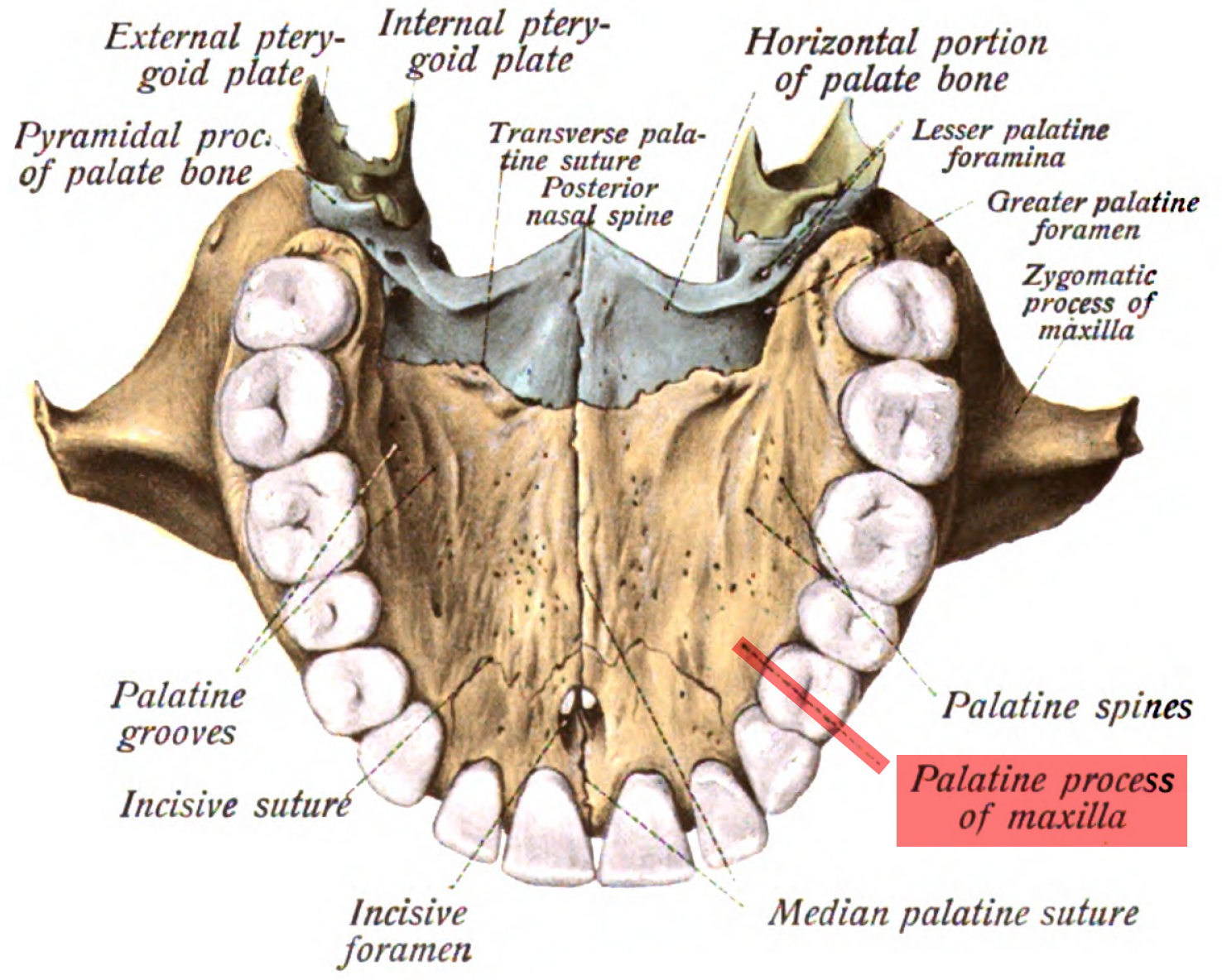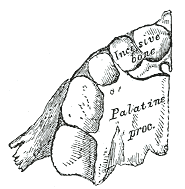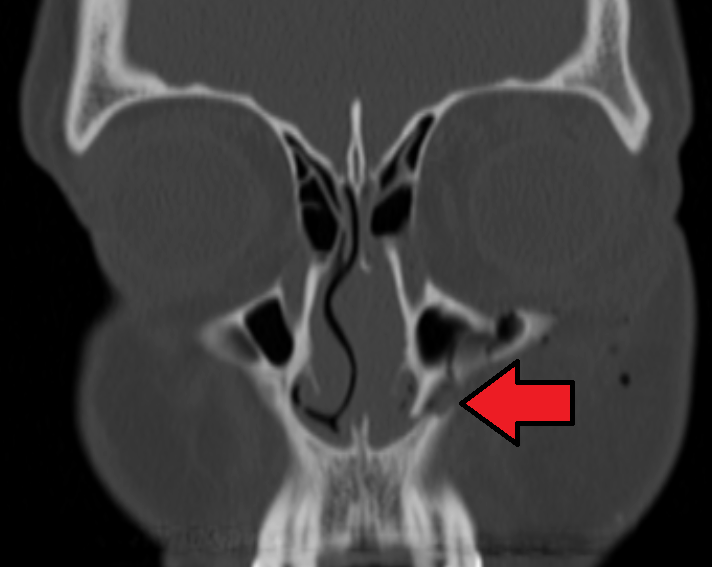Maxilla on:
[Wikipedia]
[Google]
[Amazon]
The maxilla (plural: ''maxillae'' ) in vertebrates is the upper fixed (not fixed in Neopterygii)
 In humans, the maxilla consists of:
* The body of the maxilla
* Four
In humans, the maxilla consists of:
* The body of the maxilla
* Four

 The maxilla is ossified in membrane. Mall and Fawcett maintain that it is ossified from ''two'' centers only, one for the maxilla proper and one for the premaxilla.
These centers appear during the sixth week of prenatal development and unite in the beginning of the third month, but the suture between the two portions persists on the palate until nearly middle life. Mall states that the frontal process is developed from both centers.
The maxillary sinus appears as a shallow groove on the nasal surface of the bone about the fourth month of development, but does not reach its full size until after the second dentition.
The maxilla was formerly described as ossifying from six centers, viz.:
* One, the ''orbitonasal,'' forms that portion of the body of the bone which lies medial to the infraorbital canal, including the medial part of the floor of the orbit and the lateral wall of the nasal cavity.
* A second, the ''zygomatic,'' gives origin to the portion which lies lateral to the infraorbital canal, including the zygomatic process.
* From a third, the ''palatine,'' is developed the palatine process posterior to the incisive canal together with the adjoining part of the nasal wall.
* A fourth, the ''premaxillary,'' forms the incisive bone which carries the incisor teeth and corresponds to the premaxilla of the lower vertebrates.
* A fifth, the ''nasal,'' gives rise to the frontal process and the portion above the canine tooth.
* And a sixth, the ''infravomerine,'' lies between the palatine and premaxillary centers and beneath the vomer; this center, together with the corresponding center of the opposite bone, separates the incisive canals from each other.
The maxilla is ossified in membrane. Mall and Fawcett maintain that it is ossified from ''two'' centers only, one for the maxilla proper and one for the premaxilla.
These centers appear during the sixth week of prenatal development and unite in the beginning of the third month, but the suture between the two portions persists on the palate until nearly middle life. Mall states that the frontal process is developed from both centers.
The maxillary sinus appears as a shallow groove on the nasal surface of the bone about the fourth month of development, but does not reach its full size until after the second dentition.
The maxilla was formerly described as ossifying from six centers, viz.:
* One, the ''orbitonasal,'' forms that portion of the body of the bone which lies medial to the infraorbital canal, including the medial part of the floor of the orbit and the lateral wall of the nasal cavity.
* A second, the ''zygomatic,'' gives origin to the portion which lies lateral to the infraorbital canal, including the zygomatic process.
* From a third, the ''palatine,'' is developed the palatine process posterior to the incisive canal together with the adjoining part of the nasal wall.
* A fourth, the ''premaxillary,'' forms the incisive bone which carries the incisor teeth and corresponds to the premaxilla of the lower vertebrates.
* A fifth, the ''nasal,'' gives rise to the frontal process and the portion above the canine tooth.
* And a sixth, the ''infravomerine,'' lies between the palatine and premaxillary centers and beneath the vomer; this center, together with the corresponding center of the opposite bone, separates the incisive canals from each other.
 The alveolar process of the maxillae holds the upper teeth, and is referred to as the maxillary arch. Each maxilla attaches laterally to the zygomatic bones (cheek bones).
Each maxilla assists in forming the boundaries of three cavities:
* the roof of the mouth
* the floor and lateral wall of the
The alveolar process of the maxillae holds the upper teeth, and is referred to as the maxillary arch. Each maxilla attaches laterally to the zygomatic bones (cheek bones).
Each maxilla assists in forming the boundaries of three cavities:
* the roof of the mouth
* the floor and lateral wall of the
File:Maxilla anterior.png, Skull. Maxilla shown in green.
Maxilla - animation 02.gif, Skull. Maxilla shown in white.
bone
A bone is a rigid organ that constitutes part of the skeleton in most vertebrate animals. Bones protect the various other organs of the body, produce red and white blood cells, store minerals, provide structure and support for the body, ...
of the jaw formed from the fusion of two maxillary bones. In humans, the upper jaw includes the hard palate in the front of the mouth. The two maxillary bones are fused at the intermaxillary suture, forming the anterior nasal spine. This is similar to the mandible
In anatomy, the mandible, lower jaw or jawbone is the largest, strongest and lowest bone in the human facial skeleton. It forms the lower jaw and holds the lower teeth in place. The mandible sits beneath the maxilla. It is the only movable bone ...
(lower jaw), which is also a fusion of two mandibular bones at the mandibular symphysis. The mandible is the movable part of the jaw.
Structure
 In humans, the maxilla consists of:
* The body of the maxilla
* Four
In humans, the maxilla consists of:
* The body of the maxilla
* Four processes
A process is a series or set of activities that interact to produce a result; it may occur once-only or be recurrent or periodic.
Things called a process include:
Business and management
*Business process, activities that produce a specific se ...
** the zygomatic process
** the frontal process of maxilla
** the alveolar process
** the palatine process
* three surfaces – anterior, posterior, medial
* the Infraorbital foramen
* the maxillary sinus
* the incisive foramen
Articulations
Each maxilla articulates with nine bones: * two of the cranium: thefrontal
Front may refer to:
Arts, entertainment, and media Films
* ''The Front'' (1943 film), a 1943 Soviet drama film
* ''The Front'', 1976 film
Music
*The Front (band), an American rock band signed to Columbia Records and active in the 1980s and ea ...
and ethmoid
* seven of the face: the nasal
Nasal is an adjective referring to the nose, part of human or animal anatomy. It may also be shorthand for the following uses in combination:
* With reference to the human nose:
** Nasal administration, a method of pharmaceutical drug delivery
* ...
, zygomatic, lacrimal, inferior nasal concha, palatine, vomer, and the adjacent fused maxilla.
Sometimes it articulates with the orbital surface, and sometimes with the lateral pterygoid plate of the sphenoid.
Development

 The maxilla is ossified in membrane. Mall and Fawcett maintain that it is ossified from ''two'' centers only, one for the maxilla proper and one for the premaxilla.
These centers appear during the sixth week of prenatal development and unite in the beginning of the third month, but the suture between the two portions persists on the palate until nearly middle life. Mall states that the frontal process is developed from both centers.
The maxillary sinus appears as a shallow groove on the nasal surface of the bone about the fourth month of development, but does not reach its full size until after the second dentition.
The maxilla was formerly described as ossifying from six centers, viz.:
* One, the ''orbitonasal,'' forms that portion of the body of the bone which lies medial to the infraorbital canal, including the medial part of the floor of the orbit and the lateral wall of the nasal cavity.
* A second, the ''zygomatic,'' gives origin to the portion which lies lateral to the infraorbital canal, including the zygomatic process.
* From a third, the ''palatine,'' is developed the palatine process posterior to the incisive canal together with the adjoining part of the nasal wall.
* A fourth, the ''premaxillary,'' forms the incisive bone which carries the incisor teeth and corresponds to the premaxilla of the lower vertebrates.
* A fifth, the ''nasal,'' gives rise to the frontal process and the portion above the canine tooth.
* And a sixth, the ''infravomerine,'' lies between the palatine and premaxillary centers and beneath the vomer; this center, together with the corresponding center of the opposite bone, separates the incisive canals from each other.
The maxilla is ossified in membrane. Mall and Fawcett maintain that it is ossified from ''two'' centers only, one for the maxilla proper and one for the premaxilla.
These centers appear during the sixth week of prenatal development and unite in the beginning of the third month, but the suture between the two portions persists on the palate until nearly middle life. Mall states that the frontal process is developed from both centers.
The maxillary sinus appears as a shallow groove on the nasal surface of the bone about the fourth month of development, but does not reach its full size until after the second dentition.
The maxilla was formerly described as ossifying from six centers, viz.:
* One, the ''orbitonasal,'' forms that portion of the body of the bone which lies medial to the infraorbital canal, including the medial part of the floor of the orbit and the lateral wall of the nasal cavity.
* A second, the ''zygomatic,'' gives origin to the portion which lies lateral to the infraorbital canal, including the zygomatic process.
* From a third, the ''palatine,'' is developed the palatine process posterior to the incisive canal together with the adjoining part of the nasal wall.
* A fourth, the ''premaxillary,'' forms the incisive bone which carries the incisor teeth and corresponds to the premaxilla of the lower vertebrates.
* A fifth, the ''nasal,'' gives rise to the frontal process and the portion above the canine tooth.
* And a sixth, the ''infravomerine,'' lies between the palatine and premaxillary centers and beneath the vomer; this center, together with the corresponding center of the opposite bone, separates the incisive canals from each other.
Changes by age
At birth the transverse and antero-posterior diameters of the bone are each greater than the vertical. The frontal process is well-marked and the body of the bone consists of little more than the alveolar process, the teeth sockets reaching almost to the floor of the orbit. The maxillary sinus presents the appearance of a furrow on the lateral wall of the nose. In the adult the vertical diameter is the greatest, owing to the development of the alveolar process and the increase in size of the sinus.Function
 The alveolar process of the maxillae holds the upper teeth, and is referred to as the maxillary arch. Each maxilla attaches laterally to the zygomatic bones (cheek bones).
Each maxilla assists in forming the boundaries of three cavities:
* the roof of the mouth
* the floor and lateral wall of the
The alveolar process of the maxillae holds the upper teeth, and is referred to as the maxillary arch. Each maxilla attaches laterally to the zygomatic bones (cheek bones).
Each maxilla assists in forming the boundaries of three cavities:
* the roof of the mouth
* the floor and lateral wall of the nasal cavity
The nasal cavity is a large, air-filled space above and behind the nose in the middle of the face. The nasal septum divides the cavity into two cavities, also known as fossae. Each cavity is the continuation of one of the two nostrils. The nasal ...
* the wall of the orbit
In celestial mechanics, an orbit is the curved trajectory of an object such as the trajectory of a planet around a star, or of a natural satellite around a planet, or of an artificial satellite around an object or position in space such as ...
Each maxilla also enters into the formation of two fossae: the infratemporal and pterygopalatine, and two fissures
A fissure is a long, narrow crack opening along the surface of Earth. The term is derived from the Latin word , which means 'cleft' or 'crack'. Fissures emerge in Earth's crust, on ice sheets and glaciers, and on volcanoes.
Ground fissure
A ...
, the inferior orbital and pterygomaxillary.
-When the tender bones of the upper jaw and lower nostril are severely or repetitively damaged, at any age the surrounding cartilage can begin to deteriorate just as it does after death.
Clinical significance
A maxilla fracture is a form offacial fracture
Facial trauma, also called maxillofacial trauma, is any physical trauma to the face. Facial trauma can involve soft tissue injuries such as burns, lacerations and bruises, or fractures of the facial bones such as nasal fractures and fractures ...
. A maxilla fracture is often the result of facial trauma such as violence, falls or automobile accidents. Maxilla fractures are classified according to the Le Fort classification.
In other animals
Sometimes (e.g. in bony fish), the maxilla is called "upper maxilla", with the mandible being the "lower maxilla". Conversely, in birds the upper jaw is often called "upper mandible". In most vertebrates, the foremost part of the upper jaw, to which the incisors are attached in mammals consists of a separate pair of bones, thepremaxilla
The premaxilla (or praemaxilla) is one of a pair of small cranial bones at the very tip of the upper jaw of many animals, usually, but not always, bearing teeth. In humans, they are fused with the maxilla. The "premaxilla" of therian mammal has ...
e. These fuse with the maxilla proper to form the bone found in humans, and some other mammals. In bony fish, amphibians, and reptiles, both maxilla and premaxilla are relatively plate-like bones, forming only the sides of the upper jaw, and part of the face, with the premaxilla also forming the lower boundary of the nostrils. However, in mammals, the bones have curved inward, creating the palatine process and thereby also forming part of the roof of the mouth.
Bird
Birds are a group of warm-blooded vertebrates constituting the class Aves (), characterised by feathers, toothless beaked jaws, the laying of hard-shelled eggs, a high metabolic rate, a four-chambered heart, and a strong yet lightweig ...
s do not have a maxilla in the strict sense; the corresponding part of their beak
The beak, bill, or rostrum is an external anatomical structure found mostly in birds, but also in turtles, non-avian dinosaurs and a few mammals. A beak is used for eating, preening, manipulating objects, killing prey, fighting, probing for fo ...
s (mainly consisting of the premaxilla) is called "upper mandible".
Cartilaginous fish, such as sharks, also lack a true maxilla. Their upper jaw is instead formed from a cartilaginous bar that is not homologous with the bone found in other vertebrates.
Additional images
See also
* Maxillofacial surgery * Maxillary crestReferences
Further reading
* *External links
* {{Authority control Bones of the head and neck Dental anatomy Irregular bones Human mouth anatomy